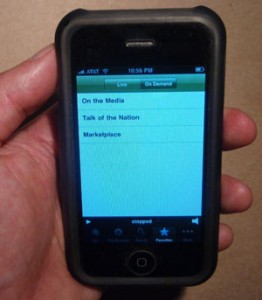I’m actually amazed at how noncommercial radio has become the site of so much innovation in the medium in the last decade, and how commercial radio is getting left in the dust. On the music side we have Seattle’s indie rock KEXP and New Jersey’s freeform WFMU which both have significant internet listenership along with substantial on demand archives and net-only programming. With traditional public radio you can find archives of nearly every nationally syndicated program, as well as live streams and internet-only shows.
Now public radio has taken a big leap in mobile with the 2.0 release of the Public Radio Player for the iPhone. The previous release of the player provided an easy way to listen to the live stream of public radio stations across the country. While a convenient app, there was little to differentiate it from any number of other apps that let you listen to live radio streams.The new 2.0 player breaks new ground by integrating on demand listening to hundreds of public radio programs, both national and local. The Public Radio Player is a collaboration between all the major public radio organizations led by the Public Radio Exchange, which is itself an innovative (but not the first) online archive of public radio content from member stations, networks and independent producers.
I’ve tried out live radio streaming to my iPhone a few times, and while it’s cool to listen to a distant station while riding the CTA home, I found that it sapped the hell out of my battery. If you want to listen for much more than an hour you need a steady source of power–a car adapter would probably suffice. More frequently, however, I’ve enjoyed the convenience of listening to podcasts, which is how I enjoy most of my favorite weekly programs.
But listening to podcasts requires some degree of forethought, making sure you subscribe and/or download programs in advance to your computer, then synchronizing them with your iPhone. You can also download podcasts directly to your iPhone from the iTunes store, but it’s not the most convenient process. You have to pick through quite a bit of chaff, you can’t search only podcasts and there’s no bookmarking function to return to your favorites.
I spent part of the afternoon trying out the new Public Radio Player 2.0 and I am quite impressed with the on demand playback. First and foremost, on demand programs are downloaded to your iPhone as they play, not streamed. This means that you don’t need to keep a constant edge or 3G connection for the duration of the program, only until it finishes downloading to your phone. That means it’s less of a drain on your battery life. It also means that you won’t lose your program in the middle when your commuter train goes into the subway.
Second, there’s an impressive inventory of programs available for on demand listening. Though I had to work a little hard to find a couple of my favorite programs, WNYC’s On the Media and WBEZ’s Sound Opinions. I could find neither program by browsing, though On the Media showed up in a search. I couldn’t find Sound Opinions at all.
And, crucially, the Public Radio Player 2.0 has a favorites list of both live and on demand programs.
To me the real innovation comes from the ability to easily listen to your favorite public radio programs on demand without having a computer at all. The favorites function makes it much more convenient to pick up daily programs as they become available. Though most daily public radio programs don’t post their podcasts until most affiliates have aired, if you’re that anxious you can still probably find a live stream.
I’m also glad to see that community radio stations are included, like Madison’s WORT. In my brief survey today I wasn’t able to identify any local community radio programs available for on demand, although the national daily news program Democracy Now–which primarily airs on community stations–is there. That may change as more stations embrace podcasts and learn to make them more accessible.
The survival of radio will depend on seeing the medium is broad terms and embracing both the traditional live, linear form and the newer nonlinear on demand world. These worlds don’t have to compete, and noncommercial radio is showing the right side of the dial how it’s done.



